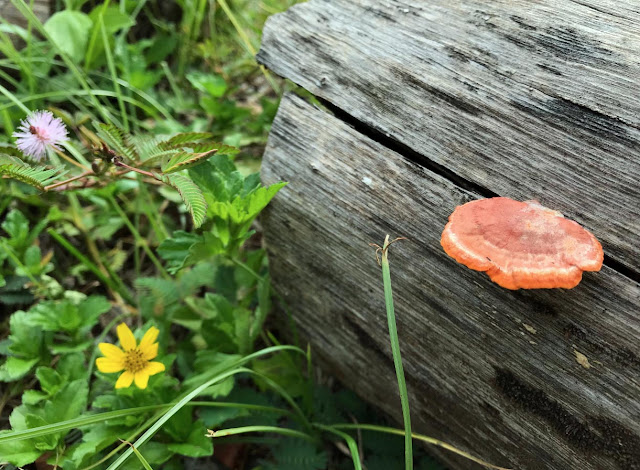Bright orange Tropical Cinnabar Bracket Fungus (Pycnoporus sanguines) is an important actor in the Central Florida ecosystem. The specimen pictured above has made its home in an oak log that has been sitting in a wet hammock near a lake for a couple of years. Other logs nearby also host this colorful fungi.
Fungi play important roles in ecosystems due to their nutritional needs as saprotrophs. Fungi including Pycnoporus sanguineus are largely responsible for the decomposition of wood, allowing for carbon and other minerals to be recycled.
Follow Phillip
Much of the Fungi is Hidden in the Wood
Large fungi (Macrofungi) are generally composed of two main parts, the mycelium which is hidden in the substrate where the fungi is found (in this case buried in the wood) and the fruiting body which forms when conditions are favorable for the fungus to disperse its spores. For identifications, the fruiting bodies are generally used instead of the mycelium due to identifiable characteristics and ease of access. The growth habits of Pycnoporus sanguineus may vary from solitary to clustered, and individuals may even appear to have fused together. When fresh, the fruiting body resembles leather in texture, but feels more flexible when dried.
The fruiting body of Pycnoporus sanguineus, comprising of a cap (pilus) and stem, is a brilliant reddish-orange in color, characteristic to all members of the Pycnoporus genus. Caps can range from 3 –14cm in diameter, and up to 5mm in thickness at the margins. Stems when present may also be 2–7cm long. The underside of the cap reveals a reddish-orange surface that contains numerous tiny circular pores (5-6 per mm).
Pycnoporus sanguineus differs from other polyporaceae (bracket fungi) due to their vibrant red-orange coloration. The vivid reddish-orange coloration of fruiting bodies is a key characteristic of all Pycnoporus members, although the vibrancy of the colors may fade over time. Caps of Pycnoporus members also turn reddish-purple to black upon contact with Potassium Hydroxide (KOH). Pores on the underside of Pycnoporus members are also bright reddish-orange in color, which does not fade. In the Pycnoporus genus, there are currently 4 known species, of which P. coccineus and P. sanguineus looks identical.
Mycoremediation
Pycnoporus sanguineus also serves as an important source of enzymes that play vital roles in various industries, especially in the paper and pulp, textile, timber, medicine and bioremediation industries Cellulase, a major enzyme used in textile, paper, detergent, food, pulp and biofuel industries can be found in Pycnoporus sanguineus. In textile industries, Cinnabarin, a pigment found in the caps of Pycnoporus sanguineus is commonly used in decolorizing particular dyes including the toxic indigo dye which has been a cause of environmental concern.
In addition to being a source of industrial enzymes and compounds, Pycnoporus sanguineus also holds a potential in the bioremediation of wastewater, crude oil spills and environments polluted by heavy metals including copper (II) ions. In Pycnoporus sanguineus and other saprobic fungus, the enzymes used in the breakdown of lignin in wood has been found to be able to perform other complex decompositions, converting sources such as plastic and oil into nutrients. Bioremediation of polluted environments using fungi is sometimes referred to as Mycoremediation.
In the close-up image above Pycnoporus sanguines reveals its dense porous underside.
Can You Eat It?
Pycnoporus sanguineus can be recognised from its thickness of the caps. Cap margins of Pycnoporus sanguineus generally grows up to about 5mm thick. The cap of pycnoporus sanguineus is also slightly more rigid than other members of the Pycnoporus genus, and its colour is more resistant to fading with time. Pycnoporus sanguineus is also more common towards the tropics.
Unless you have really strong teeth, you will not be able to eat this. It is way too tough to be eaten. Most descriptions say: Not edible. The closely related, but more northern species, P. cinnabarinus is also too tough to be edible, but makes a colorful ornament.






No comments:
Post a Comment